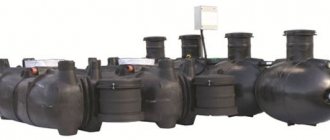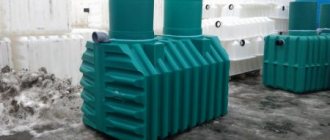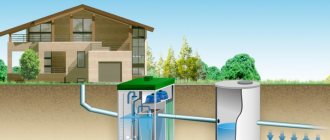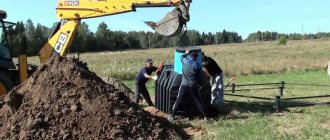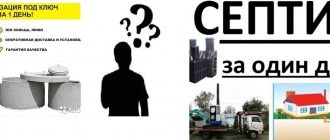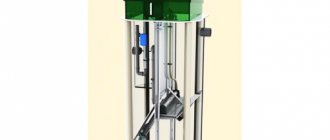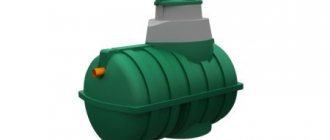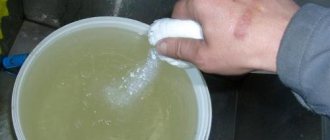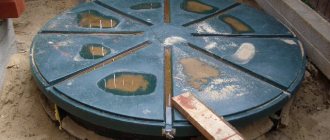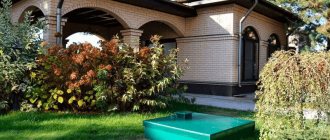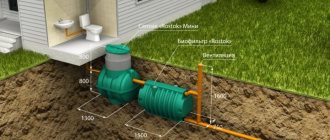Popular models of septic tanks "BioDeka"
Septic tank BioDeka-3 P-600
| More details | Users: up to 3 people Salvo discharge: 140 l. Processing volume: 0.5 m3/day Price: 73,500 rub. |
Septic tank BioDeka-5 C-1300
| More details | Users: up to 5 people Salvo discharge: 250 l. Processing volume: 1 m3/day Price: 93,200 rub. |
Septic tank BioDeka-8 C-1800
| More details | Users: up to 8 people Salvo discharge: 380 l. Processing volume: 1.6 m3/day Price: 140,000 rub. |
Septic tank BioDeka-10 P-1000
| More details | Users: up to 10 people Salvo discharge: 570 l. Processing volume: 2 m3/day Price: 150,700 rub. |
Septic tanks from
TOPAS produces septic tanks. The organization has been producing autonomous sewers for private houses, cottages and small settlements for more than 17 years. The company produces complex, individual and specialized treatment facilities. There are already more than 110,000 completed objects. All products are certified.
Conclusions: the TOPAS brand is better known and recognizable. But Deka produces a competitive product that is not inferior, and in some characteristics even superior to models from a recognized leader.
Operating instructions for owners of the Deca septic tank
The operating principle of the BioDeka 5 septic tank provides for an autonomous mode, but control by the owners is still needed. Visual inspection is carried out once a month. The tank can be installed in any soil, since the body is sealed and can withstand frost. It is allowed to install a storm sewer or drainage system to drain purified water from the septic tank.
In order for the equipment to serve for a long time and without breakdowns, it is necessary to follow the rules specified by the manufacturer in the operating instructions. General recommendations:
- It is prohibited to throw into the sewerage materials that do not decompose (solid waste, fabrics);
- it is necessary to prevent the entry into the drain of substances that are potentially dangerous for bacteria that process wastewater (chlorine, petroleum products, various alkalis and acids);
- It is necessary to carry out timely maintenance when disposing of activated sludge.
Autonomous sewerage maintenance involves the following work:
- Visual inspection for timely detection of damage.
- Checking the outlet effluent for the presence of foreign impurities and unpleasant odors.
- Estimating the amount of activated sludge, pumping out the excess at least once a year.
- Maintenance of airlifts and filters once every six months.
Popular models of septic tanks "TOPAS"
Septic tank TOPAS 8 Long Pr
| More details | Users: up to 8 people Salvo discharge: 440 l. Processing volume: 1.5 m3/day Price: 156 330 |
Septic tank TOPAS-S 10 Pr
| More details | Users: up to 10 people Salvo discharge: 760 l. Processing volume: 2 m3/day Price: 165,300 rub. |
Septic tank TOPAS 50
| More details | Users: up to 50 people Salvo discharge: 1500 l. Processing volume: 9 m3/day Price: 459 900 |
Septic tank Topas-S 5
| More details | Users: up to 5 people Salvo discharge: 220 l. Processing volume: 1 m3/day Price: 96,300 rub. |
You can get acquainted with the variety of types of autonomous sewers, as well as the list of services provided, in the catalog.
You are getting:
- Free shipping
- Installation in 1 day
- 2 year warranty
Order by phone: 8
Telephone
Pricing policy for local sewerage, guarantees
The price of equipment depends on several components: performance, type of installation and materials from which the septic tanks are made. It is best to learn more about some of these characteristics from a consultant. The rest are shown in the table below.
Table: Comparative description of the characteristics and prices of septic tanks
| BioDeka–5 C-800 | TOPAS 5 | BioDeka-8 C-800 | TOPAS 8 | BioDeca-10 C-800 | TOPAS 10 | |
| Number of users | 5 | 5 | 8 | 8 | 10 | 10 |
| Productivity, m3/day | 1 | 1 | 1,6 | 1,5 | 2 | 2 |
| Salvo release, l | 250 | 220 | 380 | 440 | 570 | 760 |
| Price, rub, including VAT | 93000 | 98900 | 117700 | 124700 | 143100 | 162600 |
| Warranty, months | 36 | 36 | 36 | 36 | 36 | 36 |
Conclusions:
- The price for TOPAS is 5-10% higher than for BioDeka.
- Manufacturers provide the same warranty – 3 years.
Types of popular septic tanks Deka
The manufacturer produces several models of septic tanks, taking into account the number of water users in the house. The numbers indicated in the marking, for example 3, 5, 8 and 10, mean that this is the number of users the tank is designed for.
Among the most popular models are the following:
- BioDeca-3 S-600. A budget model designed for a family of 3 people, even if they use the sewer system at the same time. The small dimensions of the unit facilitate installation. Sewage pipes enter the tank at a depth of 60 cm, so for regions with cold winters, thermal insulation of communications is necessary.
- BioDeca-5 P-1300. The principle of operation of the Deca 5 septic tank is no different, but in comparison with the previous model, the tank is designed for a larger number of users. Other differences: greater height, and sewer pipes are buried 130 cm. The system can be installed in any region of the Russian Federation, regardless of the level of soil freezing. There is no need to insulate communications. Marking with the letters “S” and “P” means gravity or forced movement of wastewater. Forced drainage is chosen for areas where groundwater is high.
- BioDeka-8 P-1800. The system is designed for 8 users, so it can serve 2 neighboring houses with up to four residents in each. The overall design with a 180 cm deepening of sewer pipes is suitable for use in regions with frosty winters.
Installations designed for 20 users are suitable for gas stations, public buildings, mini-hotels, cafes.
Current prices for septic tanks “BioDeka” and “TOPAS”
Septic tank BioDeka-8 C-800
| More details | Users: up to 8 people Salvo discharge: 380 l. Processing volume: 1.6 m3/day Price: 107,300 rub. |
Septic tank BioDeka-10 C-800
| More details | Users: up to 10 people Salvo discharge: 570 l. Processing volume: 2 m3/day Price: 140,900 rub. |
Septic tank Topas 10
| More details | Users: up to 10 people Salvo discharge: 760 l. Processing volume: 2 m3/day Price: 158 400 |
Septic tank Topas 8
| More details | Users: up to 8 people Salvo discharge: 440 l. Processing volume: 1.5 m3/day Price: 121 950 |
Technical characteristics of installations
To compare 2 types of local sewerage, let’s take two installations of running capacity based on the number of users of 5 people, which are suitable for a summer house, private house or cottage:
| Model | BioDeca-5 C-800 | TOPAS 5 |
| Type | Biological treatment station | Biological treatment station |
| Material | polypropylene | polypropylene |
| Case shape | cylindrical | square |
| Processing volume m3/day | 1 | 1 |
| Volley discharge, liters | 250 | 220 |
| Weight, kg | 200 | 230 |
| Alarm | in stock | Additional installation equipment is possible |
| Electronics | 1 compressor | 2 compressors |
| Anti-clog protection | film degasser | film remover |
Note that the range of TOPAS models (users up to 150 people, salvo discharge 4500 liters and processing volume 24 m3/day) is wider than that of BioDek (with a maximum number of users 20 people, salvo discharge 950 liters. , and a productivity of 4 m3/day). Therefore, first you need to decide exactly what power is needed in each specific case.
The lineup
The range of Deka septic tanks is quite wide, which will allow you to choose a station that is suitable for a summer house or a private permanent home. Options:
- Deck 3. Daily productivity is 0.6 m³, this is enough for three people. The maximum salvo discharge is 180 liters, the station weighs 158 kg.
- Septic tank Deka 5 is designed for five residents, its daily productivity is 1 m³. The salvo discharge is almost 2 times greater than that of the previous model - 344 liters. Weighs 230 kg.
- Septic tank BioDeka 5 Long. This is a modification of the previous type. The station's parameters are the same in terms of performance. The dimensions are slightly different, because the station is designed for installation for a pipe line laid at a depth of up to 1.2 m. The installation weighs 254 kg.
- Deca 7 and 7 Long. Suitable for serving 7 people. The long modification is used for deep passage of the highway. Productivity 1.4 m³ per day.
- Deca 10 and 10 Long, productivity 2 m³ per day.
- Deca 15 and 15 Long, productivity 3 m³.
- Decks 20 and 20 Long can handle wastewater in a volume of 4 m³ per day.
Characteristics of septic tanks “BioDeka 5 C-800” and “TOPAS 5”
Septic tank BioDeka-5 C-800
| More details | Users: up to 5 people Salvo discharge: 250 l. Processing volume: 1 m3/day Price: 85,900 rub. |
Septic tank Topas 5
| More details | Users: up to 5 people Salvo discharge: 220 l. Processing volume: 1 m3/day Price: 101 070 |
Conclusions:
- The table shows that in terms of parameters and characteristics, the two septic tanks are similar and there is no fundamental difference in them. The housing of autonomous sewers is made of polypropylene, which is highly durable.
- Also, a common feature of septic tanks is the degree of purification equal to 98%, which allows you to safely use the outlet water for household purposes.
Autonomous sewerage rating
Our company has been on the market for 11 years and during this time has installed more than 8,300 objects. Based on sales data for 2005-2016. statistical data on the popularity of one or another type of treatment plant was obtained. The data is presented in a chart.
The diagram shows that the Unilos Astra models are the most popular, since they are the most acceptable in terms of price-quality parameters. Topas takes a confident second place, since after the manufacturer Topol-Eco raised prices, not everyone agrees to overpay about 10 thousand rubles for an almost similar internal device.
It is obvious that consumer preferences are based on numerous reviews on forums and recommendations from friends - indeed, there are practically no complaints about these two biological treatment stations. Other biological treatment stations charge less, however, no complaints were recorded regarding Eurobion and Biodeka. Apparently, people still do not fully trust the new products on the market, because Astra and Topas have already been tested over decades of work.
What is the difference between TOPAS and BioDeka septic tanks?
Shape
- BioDeck has a cylindrical body, reinforced with stiffeners. When filled with liquid, the pressure outside and inside is distributed evenly.
- The “TOPAS” body has the shape of a parallelepiped; accordingly, when filling, the pressure is distributed unevenly, and there is a risk of deformation. Therefore, before filling, additional screeding with clamps is required. In this case, an important point is the fact that stagnant processes occur in the corners of the square, which cannot happen in a cylinder.
Differences between septic tanks "BioDeka" and "TOPAS" in shape
Septic tank BioDeka-15 C-800
| More details | Users: up to 15 people Salvo discharge: 750 l. Processing volume: 3 m3/day Price: 172,400 rub. |
Septic tank BioDeka-15 C-1500
| More details | Users: up to 15 people Salvo discharge: 750 l. Processing volume: 3 m3/day Price: 191,800 rub. |
Septic tank TOPAS 20
| More details | Users: up to 15-20 people Salvo discharge: 1000 l. Processing volume: 4 m3/day Price: 257 130 |
Septic tank TOPAS 30
| More details | Users: up to 30 people Salvo discharge: 1200 l. Processing volume: 6 m3/day Price: 323 190 |
Useful volume
- “BioDek” and “TOPAS” with equal power, due to their different shapes, have different tank volumes. The cylinder holds 15% less waste than TOPAS.
Differences in septic tanks "BioDeka" and "TOPAS" in volume
Septic tank BioDeka-5 P-1300
| More details | Users: up to 5 people Salvo discharge: 250 l. Processing volume: 1 m3/day Price: 95,400 rub. |
Septic tank BioDeka-20 C-1500
| More details | Users: up to 20 people Salvo discharge: 950 l. Processing volume: 4 m3/day Price: 253,200 rub. |
Septic tank TOPAS 40
| More details | Users: up to 40 people Salvo discharge: 1300 l. Processing volume: 7 m3/day Price: 416 250 |
Septic tank TOPAS 75
| More details | Users: up to 75 people Salvo discharge: 2250 l. Processing volume: 12 m3/day Price: 562 320 |
Technological features
- "BioDeka" works in one mode, i.e. has a single compressor. Therefore, the station is simple and reliable in operation. There is no float in the receiving chamber, this eliminates malfunctions due to its sticking. Air is supplied to the septic tank units (airlift, aerator) simultaneously.
- "TOPAS" is equipped with two compressors, the connection to the sockets is separate. A float is installed in the receiving chamber, which controls the filling level. The disadvantage of having a float in the system is that insoluble waste (napkins, paper) can get on it, as a result of which it sticks and leads to incorrect operation of the system. This installation requires periodic maintenance due to wear and tear of various parts.
Easy to install
The installation technology for both stations is similar - both Topas and Biodeka require excavation work, including digging a pit and trench, leveling the station to level, as well as insulation (depending on the climate zone), connecting to the sewerage system of a country house and commissioning works
However, there are also differences, the main of which is the required number of people for installation, as well as the need for special lifting equipment or the lack thereof. Topas has a large wall thickness and, accordingly, with equal dimensions, a large mass. Thus, the BioDeka station, suitable for servicing 5 people, can be easily installed (including lifted and placed in the pit) by three people, while Topas of similar performance will require the participation of 5 people or even special equipment. Agree that paying for the work of 3 people is cheaper than the same work of 5 specialists, not to mention the use of special equipment at the site.
Technological features of septic tanks “BioDeka” and “TOPAS”
Septic tank BioDeka-5 P-800
| More details | Users: up to 5 people Salvo discharge: 250 l. Processing volume: 1 m3/day Price: 88,400 rub. |
Septic tank BioDeka-8 P-800
| More details | Users: up to 8 people Salvo discharge: 380 l. Processing volume: 1.6 m3/day Price: 109,600 rub. |
Septic tank TOPAS 20 Long
| More details | Users: up to 15-20 people Salvo discharge: 1000 l. Processing volume: 4 m3/day Price: 285 480 |
Septic tank TOPAS 30 Long
| More details | Users: up to 30 people Salvo discharge: 1200 l. Processing volume: 6 m3/day Price: 337 950 |
Availability of lugs
- BioDeck has a square bottom that protrudes beyond the dimensions of the installation. When backfilling, the soil presses on the convex parts and securely fixes it, protecting the septic tank from floating.
- The TOPAS cleaning system does not have lugs.
Septic tank UNILOS Astra or BioDeca? - Advantages and disadvantages
| Brand | UNILOS Astra | BioDeca |
| Year of creation of the septic tank | 2002 - Astra | 2007 - Dec 2014 - BioDeca |
| Station body | Parallelepiped | Cylindrical |
| Septic tank weight | 220 kg (Astra 5) | 135 kg (BioDeca 5) |
| Wall thickness | 15-20 mm | 8 mm |
| Price | 80,000 (for 5 people) | 83,600 (for 5 people) |
| Compressor | Secoh (Japan) Thomas (Germany) | Hailea (China) |
| Solenoid valve | Mivalt MP-160 (Czech Republic) | No |
| Lugs | No | There is |
The most popular question that comes up on the Internet is: what to choose, Astra or BioDeka septic tank? We will try to answer this question. Astra and BioDeka are designed for sewage treatment, which they do very well. But at the same time, these stations have technological differences, which raises the question: which septic tank is better, Astra or BioDeka? We will take this issue seriously and look into it in detail.
Brand strength: UNILOS Astra and BioDeca
The UNILOS Astra brand is widely represented throughout Russia, producing septic tanks and autonomous sewage systems in the thousands every month, production is located in the Moscow region. The BioDeka brand is widely represented in St. Petersburg and Moscow, septic tanks are produced in the hundreds every month, production is located in St. Petersburg. These two brands are among the top three (in addition to the Topas septic tank) best-selling autonomous sewer systems in Russia.
Experienced old or modern new?
The UNILOS Astra septic tank appeared much earlier than BioDeka, it has been produced for a long time, since 2002, so all technological errors have been eliminated, the design and technical components of the septic tank have been brought to perfection. On the other hand, the BioDeka station appeared relatively recently, in 2014, so the station is more modern, with innovative technologies.
Design of septic tank Astra and BioDeka
The design of the UNILOS Astra septic tank is a parallelepiped, while BioDek has a cylindrical shape. From a physics point of view, a cylindrical shape is better than a parallelepiped, since it better compensates for soil pressure. But in practice, this advantage is lost, since the UNILOS Astra septic tank (15-20 mm) has a machine thickness more than 2 times greater than that of BioDeka (8 mm). Therefore, both stations withstand soil pressure equally well, and the housings last for many years. Next, we will compare specific models: septic tank Astra 5 and BioDeka 5, as the most popular and widespread on the St. Petersburg market. The weight of the stations is 220 kg and 135 kg, respectively. On the one hand, lower weight is a clear advantage, since such a station is easier to transport and install in a pit. On the other hand, greater weight indicates the strength and reliability of the case, which will not crack during transportation or moving around the site. The weight of the septic tank, when choosing, plays a role when you are going to install the septic tank yourself. If you order a turnkey installation of a septic tank, then the weight of the station is not important, since the installation team independently moves around the site. When installing a turnkey septic tank, the homeowner receives a ready-made septic tank that is already installed in the pit.
Design and principle of operation of septic tanks
The operation of the installations consists of step-by-step purification of domestic water with the help of beneficial microorganisms. Bacteria, with constant access to oxygen, eat organic matter in the waste and thus purify the wastewater. The end result, after processing by bacteria and settling, we obtain process water, which can be used for irrigation and other household needs, and non-toxic sludge, used as fertilizer.
Operating principle of the TOPAS septic tank
According to the given scheme of operation of the autonomous sewage system "TOPAS", household wastewater, entering chamber "A", is divided into those that are on the surface and settling particles. Biological products act on particles and heavy ones, falling to the bottom, become silt, and light ones float to the top and decompose. Afterwards, water along with light particles, through an airlift, enters chamber “B”, while hair and part of the sludge are retained by the catcher. In an oxygen-enriched environment, microorganisms eat organic inclusions, turning the remains into sludge, while water is pumped into chamber “C”.
Operating principle of the BioDeka septic tank
“BioDeka” works as follows: sewage flows through a pipe into the first chamber, where, with the help of an aeration tank, solid particles are broken down into smaller ones. After filling the compartment, water is pumped by airlift into the second chamber. In it, microorganisms process particles, clarifying the water and producing sludge. To enrich the environment with oxygen, an aerator is installed. Next, the sludge is pumped into chamber No. 3, where sludge is blown off. Effluent from chamber No. 2 moves to chamber No. 4, in which denitrification is carried out. The last stage of purification is chamber No. 5, in which the clarified water is re-settled.
Conclusions: the operating principle of the BioDeka and TOPAS septic tanks is similar. When choosing a device, you should focus on its cost and configuration.
What is included in the factory package of local sewers
Both septic tanks consist of:
- Cases.
- Compressor.
- Compression coupling.
- Sewer outlet.
- Alarm systems.
- Float switch.
- Corrugated pipe.
- Technical passport.
In addition, the devices can be equipped with additional equipment. Such as:
- Forced diversion system.
- Capacity for forced diversion.
- Drain pump with float switch.
- Reinforced PVC hose.
- Set of fittings and connectors.
- Welding rod.
Construction of a BioDeka septic tank
Appearance of the septic tank
To find out the operating principle of the BioDeka septic tank, you should familiarize yourself with the structure of this design. The case material is high-strength plastic, allowing the system to be operated in any climatic conditions. The body has a cylindrical shape with one welded seam, which increases the reliability and strength of the structure.
The device inside is equipped with a system of cameras, which are separated from each other by partitions. Cameras perform specific functions sequentially. The system is compact and requires virtually no maintenance. There is no need to build a special access road to the station. The pumped sludge is widely used as fertilizer for plants.
The main components of the BioDeka autonomous sewage system:
Internal structure of a septic tank
- primary settling tank;
- aeration tank chamber;
- stabilizing compartment;
- denitrification zone;
- secondary settling tank;
- aerator and airlift.
The autonomous sewage system is equipped with an emergency notification.
Features of the factory configuration of septic tanks “BioDeka” and “TOPAS”
Septic tank BioDeka-3 C-600
| More details | Users: up to 3 people Salvo discharge: 140 l. Processing volume: 0.5 m3/day Price: 71,300 rub. |
Septic tank BioDeka-5 C-1800
| More details | Users: up to 5 people Salvo discharge: 250 l. Processing volume: 1 m3/day Price: 121,700 rub. |
Septic tank TOPAS 12 Pr
| More details | Users: up to 12 people Salvo discharge: 830 l. Processing volume: 2.2 m3/day Price: 173 250 |
Septic tank TOPAS-S 12 Long Pr Us
| More details | Users: up to 12 people Salvo discharge: 830 l. Processing volume: 2.2 m3/day Price: 218,300 rub. |
Conclusions: The standard equipment for local treatment facilities is different for each model. Therefore, when choosing and purchasing, you must carefully read the accompanying documentation in order to accurately find out the availability of this or that equipment. The best way out of the situation would be to call a specialist and consult with him on site or order a professional selection of a septic tank for specific needs.
Features of system installation
Its service life and ease of further maintenance depend on how correctly the septic tank is installed. It should be noted that various septic tanks can be used under certain conditions and taking into account the type of soil, the presence and depth of underground groundwater, as well as the level of freezing of the ground.
Installation of a septic tank "TOPAS"
The device is mounted in a specially dug pit so that the upper part of the lid rises 20 centimeters above ground level. This is necessary to prevent melt water from overflowing and getting inside the installation. The lid is additionally insulated with Peneplex or Energoflex. After the installation is immersed in the pit, it is sprinkled while simultaneously filling the device with water to normalize the pressure inside and outside.
Installation of a septic tank "BioDeka"
The unit is also installed in a prepared pit on a “cushion” of sand, which prevents soil subsidence. One of the important arguments in favor of this septic tank is that it can be installed in areas with different groundwater levels. Then the equipment is insulated and immersed in the pit. This is followed by commissioning work.
Theoretically, the installation of an autonomous sewage system can be done independently, but it is still better to leave this issue to the specialists of Septic North-West [/anchor], who will complete the task in one day.
Conclusions: The process of installing septic tanks from TOPAS and BioDeka is, in principle, not much different and is carried out according to a principle similar to the principle of installing any other local treatment station. But, at the same time, BioDeka is less sensitive to groundwater levels.
Positive and negative sides
The work of the autonomous sewage system Deka regularly receives a lot of reviews, from which one can judge its positive and negative aspects. Among the obvious advantages:
- High level of wastewater treatment – 98-99%.
- Installation is easy and quick.
- There is no need for a filtration field, which means it can be installed even in a small area.
- Installation warranty – 3 years.
- The system can operate for up to 50 years.
- The shape of the station is cubic, which will allow for maximum useful use of it on the site.
- The body is durable - there are stiffening ribs.
- Compactness.
Negative qualities:
- To work, you need electricity - it powers pumps that supply oxygen to the chamber with aerobic bacteria.
- Requires regular preventative maintenance.
Important! Many consider the high price to be a disadvantage. Considering the service life, the quality of wastewater treatment and the convenience of the station, such investments can become a profitable investment.
Installation of septic tank Deca
Preservation of installations
Conservation of septic tank "TOPAS"
In order to preserve the TOPAS installation, you must perform the following steps:
- De-energize the equipment.
- Gradually pump out wastewater from each chamber.
- Rinse according to instructions.
- Clean airlifts, filters, nozzles and pumps.
- Fill the unit 80% with water.
- Remove the compressors and store them in a room with positive temperatures.
- Close the lid and provide additional insulation.
It is worth noting that the water cannot be completely removed from the septic tank, as this will lead to its floating. Therefore, the wastewater is pumped out from each chamber separately, instead filling it with clean water by about 40% several times until the liquid becomes clear. All chambers are washed using this method.
Conservation of the BioDeka septic tank
"BioDeka" undergoes the conservation procedure as follows:
- The installation is disconnected from the power supply.
- The chambers are washed and cleaned of contamination.
- A drainage pump removes sediment on the stabilizer.
- Wash the filters.
- Remove the compressor and pump.
- Fill with water to the limit specified in the instructions.
- The lid is securely closed and insulated.
Particular attention should be paid to the fact that under no circumstances should soil or sand get inside the unit, which could lead to damage to the station.
Conclusions: Preservation of BioDeka septic tanks is a little easier due to the simplicity of the design and fewer components that need to be washed and dismantled.
Order by phone: 8
You are getting:
- Free shipping
- Installation in 1 day
- 2 year warranty
Telephone
Autonomous sewerage market overview
Today, there are many types of local sewerage from various manufacturers: Topas from Topol - Eco, Unilos Astra, Eurobion, Biodeka, Alta Bio, Topol from Eco - Grand, Vortex and others.
To understand which of them are the best autonomous sewage systems, let us turn to the history of the emergence of biological treatment stations .
The cleaning method itself using aerobic bacteria, which is now used in all autonomous sewers, was invented and patented by Czech engineer Jan Topol in 1994. In 1995, the patent was issued to other countries, including the Russian Federation.
It was this year that the first Czech Topas , which is the progenitor of the Topas septic tank, which we now see on the windows of engineering companies. That is, Topas is the original autonomous sewer system; other manufacturers only slightly modified the invention and introduced worthy competitors among cleaning equipment to the market.
The next manufacturer to begin producing biological treatment stations was Unilos Astra , which launched the production of sewage in 2001. The main and, in fact, the only significant difference between Astra and Topas is the presence of not two, but one compressor, which pumps water from one receiving chamber to another. This is neither a plus nor a minus, since two Topas compressors are NOT INTERCHANGEABLE, and if at least one breaks, it will need to be replaced.
Then other manufacturers began to catch up: Yubas, Deka, Eurobion in 2008, Biodeka in 2014, etc. Many of them are still regularly subject to various modifications.
This information does not indicate which autonomous sewage system is better, however, it shows where it all began and where to look for the progenitor.
How to decide which is better - “TOPAS” or “BioDeca”
As mentioned earlier, TOPAS installations of various capacities can be selected for both a private home or cottage, and for a high-rise building with a capacity of more than 100 people. Service life – 50 years. They are used both on an ongoing basis and at certain times of the year. Provided that the equipment is preserved for the time when it is not in use.
The strength of the BioDeka septic tank is the shape of the body, which allows the pressure to be evenly distributed inside and outside, as well as the lugs on the bottom. Its advantages are the possibility of installation in areas with high groundwater levels and ease of design and maintenance.
The weak point of these purification systems is their dependence on a constant supply of electricity. Interruptions in the electrical network can lead to overflow of the septic tank and insufficient operation
Warranty service
As for guarantees, then:
- Unilos Astra gives the largest guarantee for the cleaning station - as much as 5 years of warranty on the housing and internal structure of the station, 3 years on electrical equipment.
- Topas - 3 years warranty on housing and internal structure, 1 year on electrical equipment.
- Biodeca provides a 3 year warranty.
It is more difficult with guarantees for other biological treatment plants - it is extremely difficult to find information about the guarantee, although this information should be in plain view of the consumer.
In addition, the manufacturer of Astra and Topas states that the service life of their stations is over 50 years with proper maintenance. This fact guarantees that there will be no rapid wear of the equipment. According to statistics from the 11th operational experience, replacement of internal electrical equipment occurs only approximately after the 10th year of operation of the station (on average). Thus, investing in a wastewater treatment plant is truly profitable, despite the more complex design compared to the same plastic septic tank.
Distinctive features of septic tanks “BioDeka” and “TOPAS”
Septic tank BioDeka-5 P-1300
| More details | Users: up to 5 people Salvo discharge: 250 l. Processing volume: 1 m3/day Price: 95,400 rub. |
Septic tank BioDeka-10 P-800
| More details | Users: up to 10 people Salvo discharge: 570 l. Processing volume: 2 m3/day Price: 143,000 rub. |
Septic tank Topas 9
| More details | Users: up to 9 people Salvo discharge: 510 l. Processing volume: 1.7 m3/day Price: 124 200 |
Septic tank Topas 4 ave.
| More details | Users: up to 4 people Salvo discharge: 175 l. Processing volume: 0.8 m3/day Price: 97 290 |
conclusions
If you find a model from BioDeca that is suitable for its performance, buy it. For private use, products from this plant have such irreplaceable properties as:
- Easy to maintain.
- Structural strength.
- Lower cost.
As for TOPAS septic tanks, the well-known name and wide range of models are captivating. You can organize a cleaning system even for an entire neighborhood or industrial complex. Therefore, for large residential and commercial properties, opt for a more well-known brand.
To choose the appropriate option for local sewerage, please contact the contacts listed on our website and specialists will help you select, install and, of course, resolve the issue of servicing the installation.

